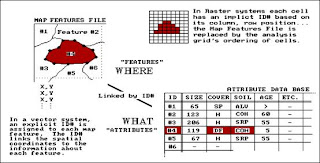WASHINGTON – The FBI conducts 165,000 fingerprint checks a day and the job just got easier.
The bureau has begun using a new computer system that takes just seven minutes to search a database of 70 million sets of fingerprints for a possible match with the fingerprints of a suspect. That's down from the old average search time of 17 minutes.
In a recent side-by-side, five-day test of the new and old computer systems, the new FBI system turned up 910 additional matches between prints submitted to the bureau and prints in the FBI's database from earlier arrests.
Engineers computed the accuracy rate of the new system at 99.6 percent, compared with the rate of 92 percent for the old system, which had been in use for more than a decade.
From the news, we can know that the improvement of databases have make our life become convenient and easier. Before the database system, many organization store or arrange their data with an older form system such as file system.
Somehow this causes many problems such as the security problems. With older form system, the database or information may spread easily to outsiders. On the other hand, it also causes data redundancy problems. The older form systems didn't effectively manage the data or information problems. It still causing a lot problems beside than two problems that mentioned.
With databases system, the organization or individual can manage their databases nicely. It solve some of the problems that occur in older form system. Besides that, with the changing of technology, the databases system keep improving and benefits to people.
So lets us go through below , learn more about the database system and also the 5 model of database.
Database System
- Typically used to encapsulate the constructs of a data model, database Management system (DBMS) and database.
- Organised pool of logically-related data. Data is stored within the data structures of the database.
- A DBMS is a suite of computer software providing the interface between users and a database or databases.
- A DBMS is a shell which surrounds a database or series of databases and through which all interactions take place with the database.
- The interactions catered for by most existing DBMS fall into four main groups:
- Data Definition. Defining new data structures for a database, removing data structures from the database, modifying the structure of existing data.
- Data Maintenance. Inserting new data into existing data structures, updating data in existing data structures, deleting data from existing data structures.
- Data Retrieval. Querying existing data by end-users and extracting data for use by application programs.
- Data Control. Creating and monitoring users of the database, restricting access to data in the database and monitoring the performance of databases.
Architecture
- Consists of three levels, external, conceptual and internal.
- External level = defines how users understand the organization of the data. A single database can have any number of views at the external level.
- Internal level = defines how the data is physically stored and processed by the computing system. Internal architecture is concerned with cost, performance, scalability and other operational matters.
- Conceptual level = indirection between internal and external. It provides a common view of the database that is uncomplicated by details of how the data is stored or managed, and that can unify the various external views into a coherent whole.
Database Management System (DBMS)
- A set of computer programs that controls the creation, maintenance, and the use of a database.
- It allows organizations to place control of database development in the hands of database administrators (DBAs) and other specialists.
- Helps the use of integrated collection of data records and files known as databases.
- It allows different user application programs to easily access the same database.
- In large systems, a DBMS allows users and other software to store and retrieve data in a structured way.
- Instead of having to write computer programs to extract information, user can ask simple questions in a query language.
- Thus, many DBMS packages provide Fourth-generation programming language (4GLs) and other application development features.
- It helps to specify the logical organization for a database and access and use the information within a database.
- It provides facilities for controlling data access, enforcing data integrity, managing concurrency, and restoring the database from backups.
- A DBMS also provides the ability to logically present database information to users.
Components
- DBMS Engine accepts logical requests from various other DBMS subsystems, converts them into physical equivalents, and actually accesses the database and data dictionary as they exist on a storage device.
- Data Definition Subsystem helps the user create and maintain the data dictionary and define the structure of the files in a database.
- Data Manipulation Subsystem helps the user to add, change, and delete information in a database and query it for valuable information. Software tools within the data manipulation subsystem are most often the primary interface between user and the information contained in a database. It allows the user to specify its logical information requirements.
- Application Generation Subsystem contains facilities to help users develop transaction-intensive applications. It usually requires that the user perform a detailed series of tasks to process a transaction. It facilitates easy-to-use data entry screens, programming languages, and interfaces.
- Data Administration Subsystem helps users manage the overall database environment by providing facilities for backup and recovery, security management, query optimization, concurrency control, and change management.
Modeling language
- A modeling language is a data modeling language to define the schema of each database hosted in the DBMS, according to the DBMS database model.
- Designed to use one of five database structures to provide simplistic access to information stored in databases.
- The five database structures are:
- The Hierarchical Model,
- The Network Model,
- The Relational Model,
- The Multidimensional Model
- The Object Model.
- Inverted lists and other methods are also used. A given database management system may provide one or more of the five models. The optimal structure depends on the natural organization of the application's data, and on the application's requirements, which include transaction rate (speed), reliability, maintainability, scalability, and cost.
The Hierarchical Model
- Used in early mainframe DBMS.
- Records’ relationships form a treelike model.
- This structure is simple but nonflexible because the relationship is confined to a one-to-many relationship.
- IBM’s IMS system and the RDM Mobile are examples of a hierarchical database system with multiple hierarchies over the same data.
- RDM Mobile is a newly designed embedded database for a mobile computer system.
- The hierarchical structure is used primarily today for storing geographic information and file systems.
The Network Model
- Consists of more complex relationships.
- Unlike the hierarchical structure, it can relate to many records and accesses them by following one of several paths.
- Allows for many-to-many relationships.
- The most commonly used today.
- It is used by mainframe, midrange and microcomputer systems.
- It uses two-dimensional rows and columns to store data.
- The tables of records can be connected by common key values.
- While working for IBM, E.F. Codd designed this structure in 1970.
- The model is not easy for the end user to run queries with because it may require a complex combination of many tables.
The Multidimensional Model
- Similar to the relational model.
- The dimensions of the cube-like model have data relating to elements in each cell.
- This structure gives a spreadsheet-like view of data.
- This structure is easy to maintain because records are stored as fundamental attributes - in the same way they are viewed - and the structure is easy to understand.
- Its high performance has made it the most popular database structure when it comes to enabling online analytical processing (OLAP).
- Has the ability to handle graphics, pictures, voice and text, types of data, without difficultly unlike the other database structures.
- This structure is popular for multimedia Web-based applications.
- It was designed to work with object-oriented programming languages such as Java.
- Use today is the ad hoc one embedded in SQL, despite the objections of purists who believe this model is a corruption of the relational model since it violates several fundamental principles for the sake of practicality and performance.
- Many DBMSs also support the Open Database Connectivity API that supports a standard way for programmers to access the DBMS.
Before the database management approach, organizations relied on file processing systems to organize, store, and process data files.
End users criticized file processing because the data is stored in many different files and each organized in a different way.
Each file was specialized to be used with a specific application. File processing was bulky, costly and nonflexible when it came to supplying needed data accurately and promptly.
Data redundancy is an issue with the file processing system because the independent data files produce duplicate data so when updates were needed each separate file would need to be updated.
Another issue is the lack of data integration. The data is dependent on other data to organize and store it.
Lastly, there was not any consistency or standardization of the data in a file processing system which makes maintenance difficult. For these reasons, the database management approach was produced.
Data structure (fields, records, files and objects)
- Optimized to deal with very large amounts of data stored on a permanent data storage device (which implies relatively slow access compared to volatile main memory).
Structured Query Language (SQL)
- Is a database computer language designed for managing data in relational database management systems (RDBMS)
- Originally based upon relational algebra and calculus.
- Its scope includes data insert, query, update and delete, schema creation and modification, and data access control.
- Despite not adhering to the relational model as described by Codd, it became the most widely used database language.
Below is the video that introduce us about SQL, so let have a look ....
Below is the video that introduce us about SQL, so let have a look ....
Reference from:
1. Computing Essentials Complete 2010 by Timothy J.O'Leary and Linda I.O'Leary from McGRAW Hill
2. http://en.wikipedia.org/wiki/Database
3. http://news.yahoo.com/s/ap/20110308/ap_on_re_us/us_fbi_fingerprints_1
4. http://en.wikipedia.org/wiki/SQL














0 comments:
Post a Comment